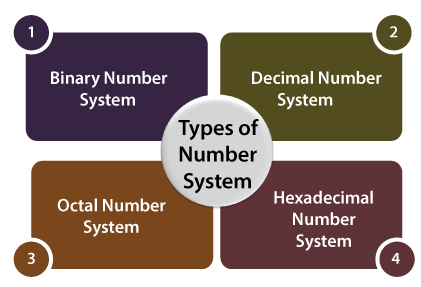Number System
In a digital system, the system can understand only the optional number system. In these systems, digits symbols are used to represent different values, depending on the index from which it settled in the number system.
In simple terms, for representing the information, we use the number system in the digital system.

The digit value in the number system is calculated using:
- The digit
- The index, where the digit is present in the number.
- Finally, the base numbers, the total number of digits available in the number system.
Note: When the number system represents a digit from 0 – 9, the base of the number will be 10.
Types of Number System
In the digital computer, there are various types of number systems used for representing information.
- Binary Number System
- Decimal Number System
- Hexadecimal Number System
- Octal Number System

Binary Number System
Generally, a binary number system is used in the digital computers. In this number system, it carries only two digits, either 0 or 1. There are two types of electronic pulses present in a binary number system. The first one is the absence of an electronic pulse representing ‘0’and second one is the presence of electronic pulse representing ‘1’. Each digit is known as a bit. A four-bit collection (1101) is known as a nibble, and a collection of eight bits (11001010) is known as a byte. The location of a digit in a binary number represents a specific power of the base (2) of the number system.
Characteristics:
- It holds only two values, i.e., either 0 or 1.
- It is also known as the base 2 number system.
- The position of a digit represents the 0 power of the base(2). Example: 20
- The position of the last digit represents the x power of the base(2). Example: 2x, where x represents the last position, i.e., 1
Examples:
(10100)2, (11011)2, (11001)2, (000101)2, (011010)2.
Decimal Number System
The decimal numbers are used in our day to day life. The decimal number system contains ten digits from 0 to 9(base 10). Here, the successive place value or position, left to the decimal point holds units, tens, hundreds, thousands, and so on.
The position in the decimal number system specifies the power of the base (10). The 0 is the minimum value of the digit, and 9 is the maximum value of the digit. For example, the decimal number 2541 consist of the digit 1 in the unit position, 4 in the tens position, 5 in the hundreds position, and 2 in the thousand positions and the value will be written as:
(2×1000) + (5×100) + (4×10) + (1×1) (2×103) + (5×102) + (4×101) + (1×100) 2000 + 500 + 40 + 1 2541
Octal Number System
The octal number system has base 8(means it has only eight digits from 0 to 7). There are only eight possible digit values to represent a number. With the help of only three bits, an octal number is represented. Each set of bits has a distinct value between 0 and 7.
Below, we have described certain characteristics of the octal number system:
Characteristics:
- An octal number system carries eight digits starting from 0, 1, 2, 3, 4, 5, 6, and 7.
- It is also known as the base 8 number system.
- The position of a digit represents the 0 power of the base(8). Example: 80
- The position of the last digit represents the x power of the base(8). Example: 8x, where x represents the last position, i.e., 1
| Number | Octal Number |
|---|---|
| 0 | 000 |
| 1 | 001 |
| 2 | 010 |
| 3 | 011 |
| 4 | 100 |
| 5 | 101 |
| 6 | 110 |
| 7 | 111 |
Examples:
(273)8, (5644)8, (0.5365)8, (1123)8, (1223)8.
Hexadecimal Number System
It is another technique to represent the number in the digital system called the hexadecimal number system. The number system has a base of 16 means there are total 16 symbols(0, 1, 2, 3, 4, 5, 6, 7, 8, 9, A, B, C, D, E, F) used for representing a number. The single-bit representation of decimal values10, 11, 12, 13, 14, and 15 are represented by A, B, C, D, E, and F. Only 4 bits are required for representing a number in a hexadecimal number. Each set of bits has a distinct value between 0 and 15. There are the following characteristics of the octal number system:
Characteristics:
- It has ten digits from 0 to 9 and 6 letters from A to F.
- The letters from A to F defines numbers from 10 to 15.
- It is also known as the base 16number system.
- In hexadecimal number, the position of a digit represents the 0 power of the base(16). Example: 160
- In hexadecimal number, the position of the last digit represents the x power of the base(16). Example: 16x, where x represents the last position, i.e., 1
| Binary Number | Hexadecimal Number |
|---|---|
| 0000 | 0 |
| 0001 | 1 |
| 0010 | 2 |
| 0011 | 3 |
| 0100 | 4 |
| 0101 | 5 |
| 0110 | 6 |
| 0111 | 7 |
| 1000 | 8 |
| 1001 | 9 |
| 1010 | A |
| 1011 | B |
| 1100 | C |
| 1101 | D |
| 1110 | E |
| 1111 | F |
Examples:
(FAC2)16, (564)16, (0ABD5)16, (1123)16, (11F3)16.
